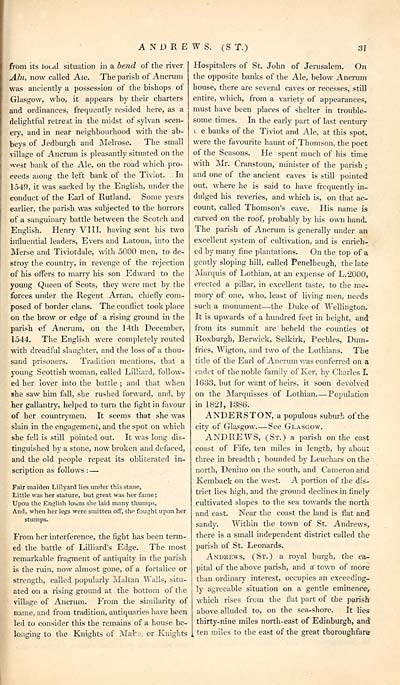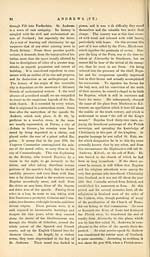Gazetteer of Scotland > Volume 1
(59) Page 31
Download files
Complete book:
Individual page:
Thumbnail gallery: Grid view | List view

ANDREWS. (S T.)
31
from its local situation in a bend of the river
Aln, now called Are. The parish of Ancram
was anciently a possession of the bishops of
j Glasgow, who, it appears by their charters
and ordinances, frequently resided here, as a
delightful retreat in the midst of sylvan scen-
ery, and in near neighbourhood with the ab-
beys of Jedburgh and Melrose. The small
village of Ancrum is pleasantly situated on the
west bank of the Ale, on the road which pro-
ceeds aiong the left bank of the Tiviot. In
1549, it was sacked by the English, under the
conduct of the Earl of Rutland. Some years
earlier, the parish was subjected to the horrors
of a sanguinary battle between the Scotch and
English. Henry VIII. having sent his two
influential leaders, Evers and Latoun, into the
Merse and Tiviotdale, with 5000 men, to de-
stroy the country, in revenge of the rejection
of his offers to marry his son Edward to the
young Queen of Scots, they were met by the
forces under the Regent Arran, chiefly com-
posed of border clans. The conflict took place
on the brow or edge of a rising ground in the
parish of Ancrum, on the 14th December,
1544. The English were completely routed
with dreadful slaughter, and the loss of a thou-
sand prisoners. Tradition mentions, that a
young Scottish woman, called Lilliard, follow-
ed her lover into the battle ; and that when
she saw him fall, she rushed forward, and, by
her gallantry, helped to turn the fight in favour
of her countrymen. It seems that she was
slain in the engagement, and the spot on which
she fell is still pointed out. It was long dis-
tinguished by a stone, now broken and defaced,
and the old people repeat its obliterated in-
scription as follows : —
Fair maiden Lillyard lies under this stane,
Little was her stature, but great was her fame ;
Upon the English louns she laid many thumps,
And, when her legs were smitten off, she fought upon her
stumps.
From her interference, the fight has been term-
ed the battle of Lilliard's Edge. The most
remarkable fragment of antiquity in the parish
is the ruin, now almost gone, of a fortalice or
strength, called popularly Maltan Walls, situ-
ated on a rising grotmd at the bottom of the
village of Ancrum. From the similarity of
name, and from tradition, antiquaries have been
led to consider this the remains of a house be-
longing to the Knights of Malta, or Knights
Hospitalers of St. John of Jerusalem. On
the opposite banks of the Ale, below Ancrum
house, there are several caves or recesses, still
entire, which, from a variety of appearances,
must have been places of shelter in trouble-
some times. In the early part of last century
i e banks of the Tiviot and Ale, at this spot,
were the favourite haunt of Thomson, the poet
of the Seasons. He spent much of his time
with Mr. Cranstoun, minister of the parish ;
and one of the ancient caves is still pointed
out, where he is said to have frequently in-
dulged his reveries, and which is, on that ac-
count, called Thomson's cave. His name is
carved on the roof, probably by his own hand.
The parish of Ancmm is generally under an
excellent system of cultivation, and is enrich-
ed by many fine plantations. On the top of a
gently sloping hill, called Penelheugh, the late
Marquis of Lothian, at an expense of L.2000,
erected a pillar, in excellent taste, to the me-
mory of one, who, least of living men, needs
such a monument — the Duke of Wellington.
It is upwards of a hundred feet in height, and
from its summit are beheld the counties ot
Roxburgh, Rerwick, Selkirk, Peebles, Dum-
fries, Wigton, and two of the Lothians. The
title of the Earl of Ancrum was conferred on a
cadet of the noble family of Ker, by Charles I.
1633, but for want of heirs, it soon devolved
on the Marquisses of Lothian Population
in 1821, 1386.
ANDERSTON, a populous suburb of the
city of Glasgow. — See Glasgow.
ANDREWS, (St.) a parish on the east
coast of Fife, ten miles in length, by about
three in breadth ; bounded by Leuchars on the
north, Denino on the south, and Cameron and
Kemback on the west. A portion of the dis-
trict lies high, and the ground declines in finely
cultivated slopes to the sea towards the north
and east. Near the coast the land is flat and
sandy. Within the town of St. Andrews,
there is a small independent district called the
parish of St. Leonards.
Andrews, (St.) a royal burgh, the ca-
pital of the above parish, and a~ town of more
than ordinary interest, occupies an exceeding-
ly agreeable situation on a gentle eminence,
which rises from the flat part of the parish
above alluded to, on the sea-shore. It lies
thirty-nine miles north-east of Edinburgh, and
| ten miles to the east of the great thoroughfare
31
from its local situation in a bend of the river
Aln, now called Are. The parish of Ancram
was anciently a possession of the bishops of
j Glasgow, who, it appears by their charters
and ordinances, frequently resided here, as a
delightful retreat in the midst of sylvan scen-
ery, and in near neighbourhood with the ab-
beys of Jedburgh and Melrose. The small
village of Ancrum is pleasantly situated on the
west bank of the Ale, on the road which pro-
ceeds aiong the left bank of the Tiviot. In
1549, it was sacked by the English, under the
conduct of the Earl of Rutland. Some years
earlier, the parish was subjected to the horrors
of a sanguinary battle between the Scotch and
English. Henry VIII. having sent his two
influential leaders, Evers and Latoun, into the
Merse and Tiviotdale, with 5000 men, to de-
stroy the country, in revenge of the rejection
of his offers to marry his son Edward to the
young Queen of Scots, they were met by the
forces under the Regent Arran, chiefly com-
posed of border clans. The conflict took place
on the brow or edge of a rising ground in the
parish of Ancrum, on the 14th December,
1544. The English were completely routed
with dreadful slaughter, and the loss of a thou-
sand prisoners. Tradition mentions, that a
young Scottish woman, called Lilliard, follow-
ed her lover into the battle ; and that when
she saw him fall, she rushed forward, and, by
her gallantry, helped to turn the fight in favour
of her countrymen. It seems that she was
slain in the engagement, and the spot on which
she fell is still pointed out. It was long dis-
tinguished by a stone, now broken and defaced,
and the old people repeat its obliterated in-
scription as follows : —
Fair maiden Lillyard lies under this stane,
Little was her stature, but great was her fame ;
Upon the English louns she laid many thumps,
And, when her legs were smitten off, she fought upon her
stumps.
From her interference, the fight has been term-
ed the battle of Lilliard's Edge. The most
remarkable fragment of antiquity in the parish
is the ruin, now almost gone, of a fortalice or
strength, called popularly Maltan Walls, situ-
ated on a rising grotmd at the bottom of the
village of Ancrum. From the similarity of
name, and from tradition, antiquaries have been
led to consider this the remains of a house be-
longing to the Knights of Malta, or Knights
Hospitalers of St. John of Jerusalem. On
the opposite banks of the Ale, below Ancrum
house, there are several caves or recesses, still
entire, which, from a variety of appearances,
must have been places of shelter in trouble-
some times. In the early part of last century
i e banks of the Tiviot and Ale, at this spot,
were the favourite haunt of Thomson, the poet
of the Seasons. He spent much of his time
with Mr. Cranstoun, minister of the parish ;
and one of the ancient caves is still pointed
out, where he is said to have frequently in-
dulged his reveries, and which is, on that ac-
count, called Thomson's cave. His name is
carved on the roof, probably by his own hand.
The parish of Ancmm is generally under an
excellent system of cultivation, and is enrich-
ed by many fine plantations. On the top of a
gently sloping hill, called Penelheugh, the late
Marquis of Lothian, at an expense of L.2000,
erected a pillar, in excellent taste, to the me-
mory of one, who, least of living men, needs
such a monument — the Duke of Wellington.
It is upwards of a hundred feet in height, and
from its summit are beheld the counties ot
Roxburgh, Rerwick, Selkirk, Peebles, Dum-
fries, Wigton, and two of the Lothians. The
title of the Earl of Ancrum was conferred on a
cadet of the noble family of Ker, by Charles I.
1633, but for want of heirs, it soon devolved
on the Marquisses of Lothian Population
in 1821, 1386.
ANDERSTON, a populous suburb of the
city of Glasgow. — See Glasgow.
ANDREWS, (St.) a parish on the east
coast of Fife, ten miles in length, by about
three in breadth ; bounded by Leuchars on the
north, Denino on the south, and Cameron and
Kemback on the west. A portion of the dis-
trict lies high, and the ground declines in finely
cultivated slopes to the sea towards the north
and east. Near the coast the land is flat and
sandy. Within the town of St. Andrews,
there is a small independent district called the
parish of St. Leonards.
Andrews, (St.) a royal burgh, the ca-
pital of the above parish, and a~ town of more
than ordinary interest, occupies an exceeding-
ly agreeable situation on a gentle eminence,
which rises from the flat part of the parish
above alluded to, on the sea-shore. It lies
thirty-nine miles north-east of Edinburgh, and
| ten miles to the east of the great thoroughfare
Set display mode to: Large image | Transcription
Images and transcriptions on this page, including medium image downloads, may be used under the Creative Commons Attribution 4.0 International Licence unless otherwise stated. ![]()
| Gazetteers of Scotland, 1803-1901 > Gazetteer of Scotland > Volume 1 > (59) Page 31 |
|---|
| Permanent URL | https://digital.nls.uk/97425070 |
|---|
| Description | Volume I: Abbey to Glenartney. |
|---|---|
| Attribution and copyright: |
|
| Description | By Robert Chambers and William Chambers. Glasgow: Blackie & Son, 1838. 2 volumes. |
|---|---|
| Shelfmark | NF.1461.g.7 |
| Additional NLS resources: | |

